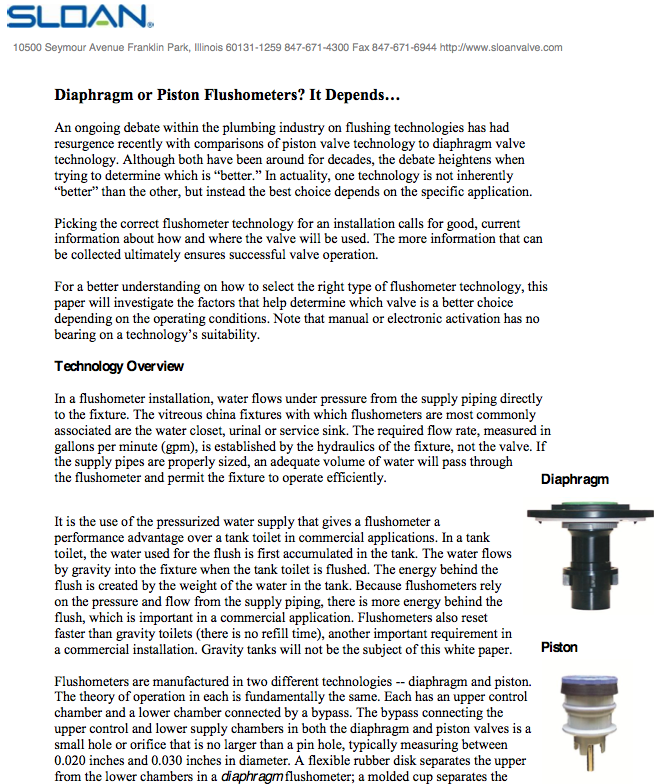How do you know when to choose diaphragm vs. piston flushometer valve technology? Sloan has issued a new white paper that discusses the differences between diaphragm and piston valve flushing technologies and includes charts that show under which operating conditions to specify one type over the other.
“Diaphragm and piston flush valves each have their strengths and are best suited for different environmental conditions,” says Mike Gipson, Flushometer Product Line Manager for Sloan. “It’s important to assess the environment before choosing to install diaphragm or piston technology.”
In addition to illustrating the mechanical differences between diaphragm and piston flushometers, the white paper highlights considerations that impact which type of technology is most appropriate for various restroom environments, including:
- High or low restroom traffic
- Water quality, including the pH of the water and chlorine concentration
- Operating conditions, such as high or low water pressure systems
Sloan invented the diaphragm flush valve more than 100 years ago and then introduced piston valves about 20 years later. Today, Sloan manufactures both diaphragm and piston flush valves in sensor-activated and manual models. Diaphragm flushometers include the Royal, UPPERCUT, Regal XL and Sloan brand valves; the Crown and GEM•2 valves are piston operated. Sloan offers flushometers for every type of environment from normal restroom applications to extremely harsh water conditions.
To help you determine which type of flushometer valve is best suited for the variety of restroom environments, download a PDF of the “Diaphragm or Piston Flushometers? It Depends...” white paper at http://www.sloanvalve.com/Water_Efficiency/SLV3583-Diaphragm_Piston_White-Paper.pdf. BD+C
Related Stories
| Nov 11, 2013
4 trends driving the recovering commercial construction sector
Jones Lang LaSalle research reveals a four-point “new look” for the post-recession construction industry.
| Nov 8, 2013
Oversized healthcare: How did we get here and how do we right-size?
Healthcare facilities, especially our nation's hospitals, have steadily become larger over the past couple of decades. The growth has occurred despite stabilization, and in some markets, a decline in inpatient utilization.
| Nov 8, 2013
Can Big Data help building owners slash op-ex budgets?
Real estate services giant Jones Lang LaSalle set out to answer these questions when it partnered with Pacific Controls to develop IntelliCommand, a 24/7 real-time remote monitoring and control service for its commercial real estate owner clients.
| Nov 8, 2013
S+T buildings embrace 'no excuses' approach to green labs
Some science-design experts once believed high levels of sustainability would be possible only for low-intensity labs in temperate zones. But recent projects prove otherwise.
| Nov 8, 2013
Net-zero bellwether demonstrates extreme green, multifamily style
The 10-unit zHome in Issaquah Highlands, Wash., is the nation’s first net-zero multifamily project, as certified this year by the International Living Future Institute.
| Nov 8, 2013
Walkable solar pavement debuts at George Washington University
George Washington University worked with supplier Onyx Solar to design and install 100 sf of walkable solar pavement at its Virginia Science and Technology Campus in Ashburn, Va.
| Nov 6, 2013
PECI tests New Buildings Institute’s plug load energy use metrics at HQ
Earlier this year, PECI used the NBI metrics to assess plug load energy use at PECI headquarters in downtown Portland, Ore. The study, which informed an energy-saving campaign, resulted in an 18 percent kWh reduction of PECI’s plug load.
| Nov 5, 2013
Net-zero movement gaining traction in U.S. schools market
As more net-zero energy schools come online, school officials are asking: Is NZE a more logical approach for school districts than holistic green buildings?
| Nov 5, 2013
New IECC provision tightens historic building exemption
The International Energy Conservation Code has been revised to eliminate what has been seen as a blanket exemption for historic buildings.
| Nov 5, 2013
Living Building Challenge clarifies net-zero definitions and standards
The Living Building Challenge has released the Net Zero Energy Building Certification to provide clearer definitions regarding what net zero really means and how it is to be achieved.

















